#2. Odessa Talks to Oreo about Apple Snails:
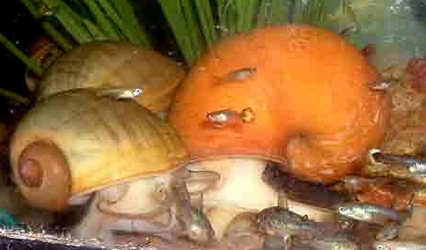
Dear Oreo,
Did I ever tell you that I have some amphibious cousins living in my human's home as well as numerous other critters. These snails are called canas, or apple snails.
Mom (my human Mom that is) bought these at a local department store. In stores and pet shops, the dark colored snails are often called Canas or mystery snails and the gold-colored ones are called Gold canas or Golden Inca snails. They are all Apple snails more correctly Channeled apple snails. You and I being well-educated snails recognize them by their Latin name: Pomacea canaliculata and they were named by a Malacologist by the name of Lamarck in the year 1822. Wow, that was a long time ago. (NOTE: a malacologist is a scientist who studies molluscs - snails).
|
Mom's oldest Apple snail is called Barney. She is now about 15 months old and is very large for a captive freshwater apple snail. Unlike most snail who are both male and female (hermaphrodites) Apple snails are male or female (separate sexes).
Over the past 15 months, Barney has laid many, many egg clutches. Mom said she has laid thousands of eggs In her lifetime. When she was younger she would sometimes lay 3 huge clutches a week and in those egg clutches there would be on an average of 400 eggs! She would do this for a week, skip a week or two and then start all over again. |
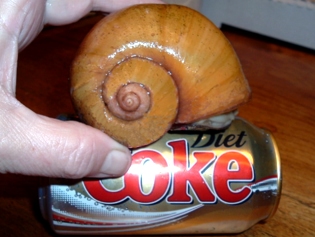 |
Apple snails are native to South America where they live from Argentina northwards to the Amazon basin. They like to live in lakes, ponds and swamps. An interesting thing about apple snails is that they are amphibious (they live and move about in and out of the water - fresh water only - never salt water). They usually sleep under their watery home during the day, hidden in vegetation near the waters surface, then at night they get more active and they actually leave the water in search of their favorite foods - fresh tender plants.
One time, Mom got some some of these snails from a local store. She kept them in a big washtub outside the back of our house while she was preparing a proper aquarium for them. This was before she knew they could move about outside of their watery home in search of food. Well they ended up staying out over night. Can you imagine how upset she and especially my human Dad would have been if they had gotten hungry and eaten all their vegetable garden up during the night. Mom got lucky - they must not have been hungry as all was well in the morning. Lucky!!!
|
I think canas will eat everything!!! They eat all kinds of freshwater plants and they will even eat other snails. YIKES! Look at Mom's pet Cana, Bernice and all the baby canas here devouring a head of lettuce in their aquarium.
Oreo, did you know that ten adult Canas can eat almost a whole head of lettuce in one night! Its true, I saw this with my own eyes. They're real pigs!!
There is no way you can have living plants in their aquarium They would just eat them. |
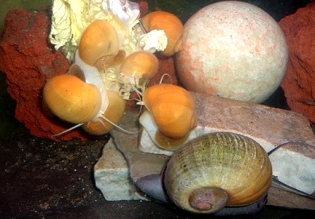 |
Another fact about Apple snails is that they can be eaten by humans. And because they are BIG and grow and multiply fast they were at one time considered a possible food source for some countries other than their own home in South America. So again, man took things into his own hands and actually released apple snails in foreign lands such as China and Taiwan (**see list at page bottom).
They never looked at what negative effects these snails could have in nonnative environments.
The first problem to be encountered was - most of the people did not like the taste of these new snails so they didn't eat them. The second problem soon became very evident. Even though they did not like the taste of these new snails, these new snails very much liked of their foods such as their crops of tender rice plants, (they will eat roots and all), and many other natural native plants.
Because they were not really liked as a food source (The YUCK factor) The apple snails were not harvested in sufficient quantities to control their rate of reproduction - they then ate the native's natural green foods and produced more snails which in turn ate more crops and gardens!
BIG PROBLEMS!
Loss of crops, disturbed ecosystems and that is not the only problems; these snails can carry very bad parasites that can make people very sick or they may even die!
The
people have tried using chemical pesticides and molluscicides on
these snails to control them and
not only are they are expensive, they too have caused
many problems on their environments and on their health ... More problems!
|
Apple snails have one more trick up their shells: Even if their ponds were to dry out, they just bury themselves in mud, close their shells up tight (they have a trap door which is called an operculum) and they go to sleep until conditions are better again. This is something like hibernation but is actually called aestivation. But, unlike hibernation, this sleeping state can actually last for years. Apple snails are good survivors! They can even survive in polluted water and waters low in oxygen. |
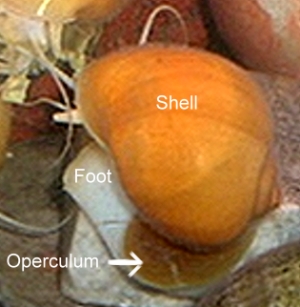 |
Well Oreo, it looks like there are all sorts of problems to be solved which involve this snail. Who ever would have thought that a beloved pet could and does cause such major problems around the world. True pets are not the main problem - but they too can become just as BIG a pest if they are let go into local waters.
You and I have a responsibility to bring these problems to the attention of pet owners every where. We must get the message to them - Please NEVER - EVER let your pet apple snails (AKA: Canas, mystery snails, gold Inca snails, gold canas, channeled apple snails) go into the outside environment. They can and will cause BIG problems.
Canas are very enjoyable pets; but, before purchasing these or any other any snails as a pet, learn all you can about them. There are pros and cons of keeping any snail. First and most important - Find out if they are legal to have as pets. Some snails, like apple snails are legal to possess, however, other snails, like the Giant African land Snails are in some states and countries are very, very illegal to keep. Learn how to care for your snails to keep them happy and healthy. Learn how long they can live so you can commit that amount of time to them. Learn how to prevent them from mass producing or you must be willing to destroy egg masses or live young to control your pet population.
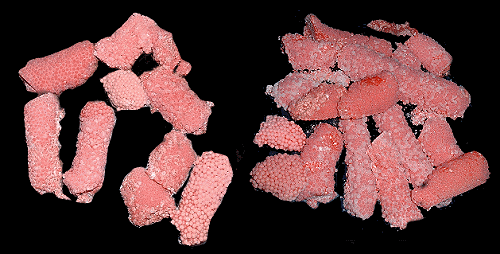 This is about one weeks worth of egg clutches collected from Barney's aquarium laid by 5 female apple snails |
Mom has many apple snails and she has told me many times that they are not the easiest of snails to keep clean and under control. She loves them dearly but they are a lot of work and she can't even go away for a few days holiday without having a baby sitter for them.
Well Oreo, I hope people read our pages and become responsible snail pets owners. Now, I must go for a long nap. I have talked myself right out again so good night for now.
Love,
Odessa
See: The
"Most Wanted
Poster" for the Apple Snails:
by Oreo and Odessa
edited for content by Avril Bourquin
NOTE: **Where Apple Snails have been introduced: Most of southern, eastern and southeast Asia, including the Philippines, Japan, Taiwan, Vietnam, Cambodia, Thailand, Laos, Korea, Sri Lanka, parts of Indonesia and Malaysia, southern China, Singapore; also Hawaii, Guam, and Papua New Guinea; the Dominican Republic; the USA (Florida, Texas, California).
|
Retrun
to the Odessa-Oreo
Article Index |
Return
to Man and Mollusc
Home Page |
